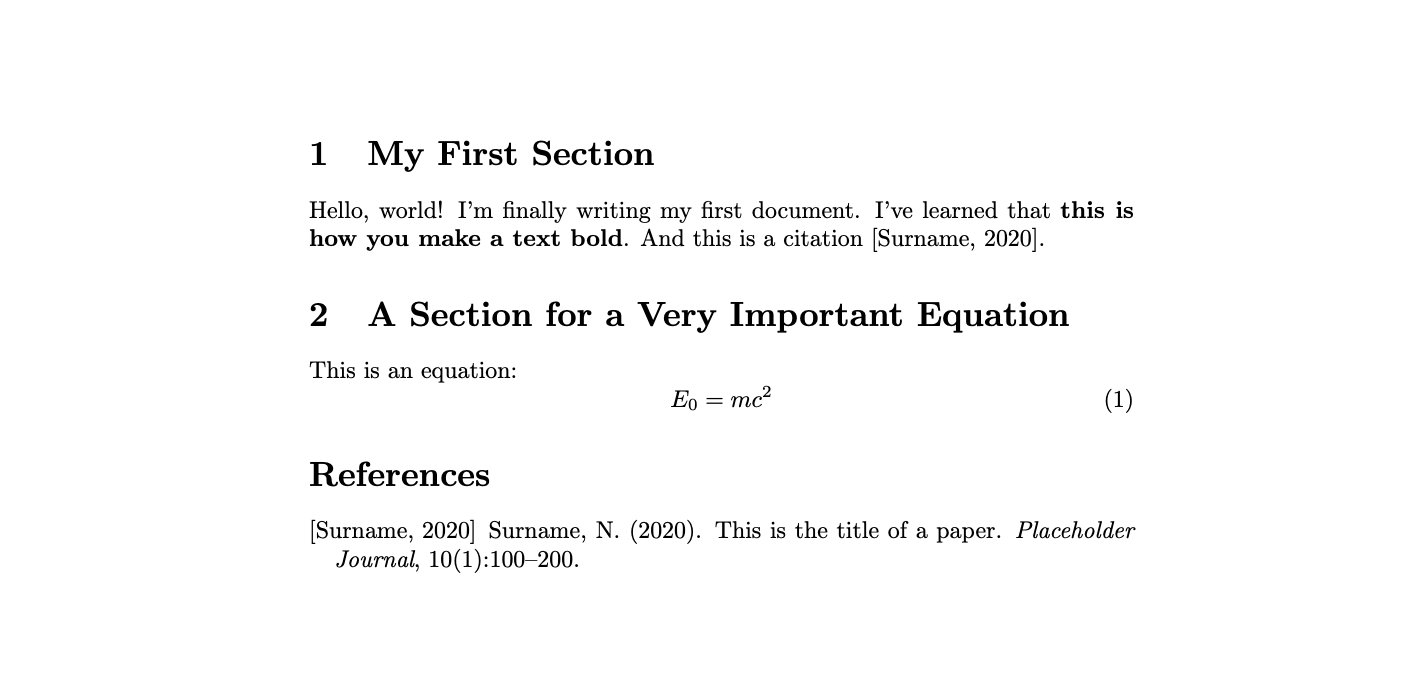Please notice that there are different ways to include a bibliography in
\(\LaTeX\)
, namely bibtex, natbib, and biblatex.
In this tutorial, we will deal with bibtex only. For more advanced uses, consider researching which system works best for you.
Create a .bib File
A .bib file contains all the bibliographic information for your document. Think of it as a sort of database of all the references you may want to include in your article (but you don’t have to necessarily).
Your .bib file must contain specific information for each entry (i.e., for each article, book, proceeding, etc. that you want to cite.)
The following is an example for an article entry:
@article{surname2020placeholder,
Author = {Surname, Name},
Date-Added = {2020-10-12 11:31:07 +0200},
Date-Modified = {2020-10-12 11:31:07 +0200},
Journal = {Placeholder Journal},
Number = {1},
Pages = {100-200},
Publisher = {PLACEHOLDER PUBLISHER},
Title = {This is the title of a paper},
Volume = {10},
Year = {2020}}
We strongly suggest to use a bibtex generator for this task. Some reference management tools can build .bib files automatically for you. More on this at the end of this tutorial.
Use BibTeX
Once the .bib file is prepared, you will need to include it in the $\LaTeX$ document.
- Place this file in the same directory of your $\LaTeX$ project.
- Add the following to your code, before closing your
documentenvironment:
...
\bibliography{bibliography}
\bibliographystyle{apalike}
\end{document}
Notice that our file is saved as bibliography.bib but we did not include the extension .bib in the \bibliography{filename} command.
You can also specify a bibliography style which will indicate how your references will look like in the bibliography section. apalike is just one of the many ones available. Here’s a comprehensive list.
- Lastly, you just need to add citations in your article. You can do so by using the
\cite{entrytag}command, where theentrytagis a custom-defined tag for each entry that you can find right after the opening brace{- in our case,surname2020placeholder.
This is some text. Here a citation will be appended\cite{surname2020placeholder}.
 Tip
TipNotice that you’re not obliged to cite all the entries in your .bib file! Only those that you’ve actually cited will appear in the bibliography section.
Wrap Up
Adding a bibliography to our previous article, we should get the following $\LaTeX$ code and output:
\documentclass{article} % Specifies that we're writing an article
\usepackage{amsmath} % Imports amsmath
\title{My First \LaTeX{} Article} % Defines the title
\author{John Doe}
\date{January 1st, 2000}
\begin{document} % Begins the document environment
\maketitle % Prints the title
\newpage % Ensures that the article starts from the next page
\section{My First Section}
Hello, world! I'm finally writing my first document. I've learned that \textbf{this is how you make a text bold}. And this is a citation \cite{surname2020placeholder}.
% This is a comment, not shown in final output.
\section{A Section for a Very Important Equation}
This is an equation:
\begin{equation} % Begins an equation environment
E_0 = mc^2
\end{equation}
\bibliography{bibliography} % Adds a bibliography
\bibliographystyle{apalike}
\end{document}








